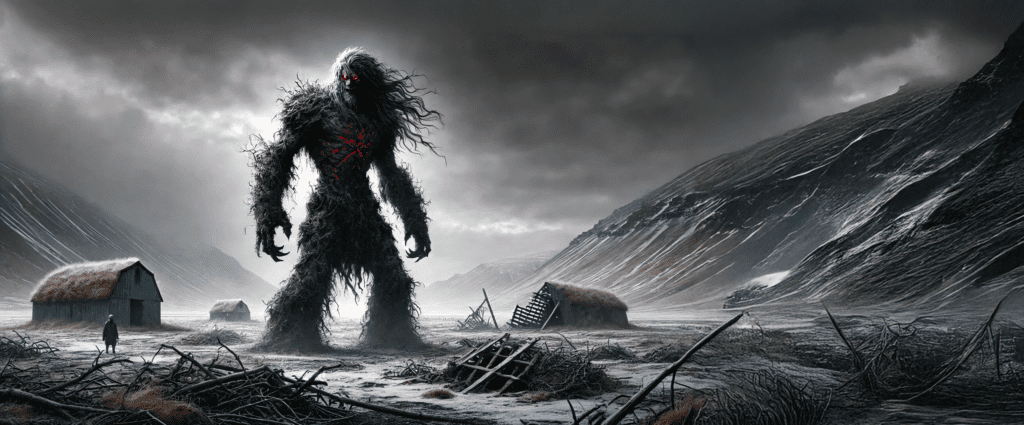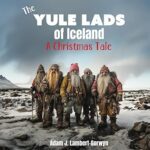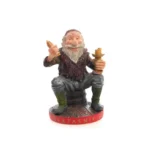Skröggur - The Destroyer

“Skröggur’s fury raged through the winter nights, leaving only ruin in his wake.”
Introduction
Skröggur, known as The Destroyer, is one of the most feared and chaotic figures among the forgotten Yule Lads. Born under dark circumstances, Skröggur’s arrival in villages signaled nothing but calamity. Unlike his mischievous brothers, Skröggur brought destruction wherever he went—toppling barns, scattering livestock, and causing structures to collapse under his raw fury. His destructive actions were not without reason, however; Skröggur’s origins lie in a troubled birth, as the illegitimate child of Grýla’s husband and a woman who was tasked with caring for Grýla when she fell ill. This affair, a betrayal that Grýla would not forgive, resulted in Skröggur being cast out, along with his mother, the caretaker named Hertha. Skröggur grew up in the wilderness, his rage fueled by the rejection from his own family and the isolation he faced.
Historical Background and Earliest Known Reference
Skröggur’s story is steeped in the darker side of Icelandic folklore. His legend is believed to have been born out of the ancient Icelandic tradition of oral storytelling, where his name was spoken in hushed tones during the winter months. Skröggur’s origins trace back to a time when Grýla fell gravely ill and required assistance. Her caretaker, a woman named Hertha, took on the responsibility of nursing Grýla back to health. During this time, however, Grýla’s husband, Leppalúði, had an illicit affair with Hertha, resulting in the birth of Skröggur. When Grýla discovered the affair, she was consumed with anger and cast both Hertha and Skröggur out of their home. As a result, Skröggur grew up separated from the Yule Lads, with only his anger and bitterness to keep him company.
Physical Appearance and Clothing
Skröggur is typically depicted as a hulking, fearsome figure with wild, tangled hair that seems to blow in the wind, no matter where he stands. His clothing is torn and tattered, representing the chaos he embodies. Skröggur wears heavy, frayed garments that once provided warmth but are now as ragged and weathered as his soul. His face is etched with the fury and rage that fuels his every move, and his eyes burn with an intensity that mirrors the storms he brings.
Likes, Dislikes, and Habits
Skröggur thrives on chaos and disorder. His greatest pleasure comes from watching carefully tended farms fall into disarray, with livestock scattered and buildings toppled. He targets those who have enjoyed too much peace and prosperity, driven by an urge to tear down what others have built. Skröggur despises calm, order, and prosperity. To him, peace is unnatural, and he sees it as his duty to disrupt it.
Types of Pranks and Mischief
Unlike his brothers, Skröggur’s pranks are far from harmless. He is responsible for some of the most catastrophic events in Yule folklore. His favorite “prank” involves whipping up violent storms that cause barns to collapse and livestock to scatter into the wilderness, leaving farmers to deal with the chaos. He is said to target homes that are filled with warmth and prosperity, turning them into scenes of devastation by morning. His pranks are not just inconvenient—they can be life-threatening, leaving families struggling to rebuild after Skröggur’s rampages.
Relationship with Humans and Other Yule Lads
Skröggur’s relationship with humans is purely antagonistic. Villagers go to great lengths to protect their homes from his destructive tendencies, offering up prayers and sometimes even sacrifices in the hopes of warding him off. Unlike the other Yule Lads, who are seen as mischievous but relatively harmless, Skröggur is viewed as a serious threat to life and livelihood.
Modern Depictions and Popularity
In modern Icelandic folklore, Skröggur’s story has faded into the background, overshadowed by the more playful Yule Lads. However, his legend still resonates with those who appreciate the darker side of Yule folklore. He remains a symbol of the destructive power of winter and the consequences of betrayal and abandonment. In recent years, Skröggur has appeared in darker retellings of Yule stories, where his destructive tendencies are used to highlight the dangers of Iceland’s harsh winters.
Fun Facts and Trivia
- Skröggur’s name translates to “The Destroyer,” emphasizing his role as a bringer of chaos and destruction.
- His association with violent winter storms made him a feared figure in early Icelandic communities.
- Skröggur’s birth story serves as a reminder of the consequences of betrayal and neglect in Icelandic folklore.
Astrological Sign: Aries
Skröggur’s fiery, destructive nature aligns with the traits of Aries. Like an Aries, he is bold, impulsive, and driven by a powerful force of energy that pushes him to act without restraint.
Cultural Significance
Skröggur’s legend serves as a reminder of the fragile balance between peace and chaos, prosperity and ruin. His story highlights the importance of vigilance during the winter months and the dangers that can come from neglect, betrayal, and abandonment. In the same way that nature’s wrath can be unpredictable and unforgiving, so too is Skröggur’s destructive rage.
Voices of Tradition
“Reiði Skröggs geisaði í gegnum vetrarnætur, skiljandi aðeins eyðileggingu eftir sig.“




